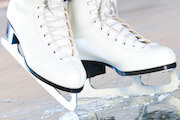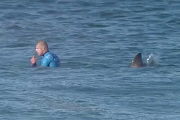 By: Simon
By: SimonKris Holm is a true pioneer for the sport of unicycling. He's taking the sport to new levels as he continues to push the envelope with his stunts and tricks. A former world champion, Kris has unicycled all over the globe. Simon sat down to chat with this legend!
Simon: How did you get involved in unicycling?
Kris Holm: When I was 11, I saw a street performer playing a violin while unicycling. I thought that was pretty amazing because I also play the violin, so I asked for a unicycle for my 12th birthday. That was in 1986. It turned out that while both violin and unicycling are difficult, putting the two together is actually quite easy. So I looked for more challenge, discovered off-road riding, and it just grew from there.
Simon: What was the specific appeal to the sport that made you want to get better?
Kris Holm: I have always liked to do adventurous, balance-oriented sports such as climbing and skiing, and I really like the idea of minimalism - that you can do more with less. With practice you can do everything on a mountain unicycle that you can do on a mountain bike, all without gears or a chain or suspension. I think that's cool, and it's a lot easier to fix and maintain!
Simon: How is unicycling different than mountain biking?
Kris Holm: Unlike a mountain bike you have no stability forwards and backwards. You have to stay upright based purely on balance and the way you pedal. In many ways this makes mountain unicycling more similar to skiing or trail running than biking, because of the way you must lean to turn and slow down or speed up.
Simon: Where have you been able to travel because of unicycling?
Kris Holm: I have been fortunate to travel to many places on my unicycle - to about 14 countries so far in Europe; South, Central and North America; and Central Asia. Two of my favorite places have been a month-long trip to the kingdom of Bhutan, in the Himalayas, and to Bolivia to attempt a descent of a 5,950 meter (19,520 feet) high volcano called Licancabur. Both trips were lifetime experiences for cultural reasons as much as riding. Bhutan is very remote and is seldom visited by westerners. We rode across an ancient trade route that has been used to bring corn and rice across the country for over a thousand years. Licancabur was an important Inca religious site, and amazingly still has Inca ruins on the summit.
Simon: What is your proudest accomplishment?
Kris Holm: Over the past 20 years and especially in the past seven years, mountain unicycling has gone from complete obscurity to a respected sport done by several hundred thousand riders on most continents. I'm proud to have had the chance to shape part of that history. Otherwise, one of my best riding days was a descent of part of the south face of El Pico de Orizaba, a 5,500 meter (18,040 feet) high volcano in Mexico.
Simon: What kind of equipment do you need for the sport?
Kris Holm: That depends on what you want to do. Street riders and trials riders use a unicycle with a small, 19" wheel that is very strong yet maneuverable and lightweight. Mountain unicyclists usually use a larger wheel that is better for rolling over bumps and traveling longer distances. Other than a unicycle, you also need proper safety gear including a helmet, shin and knee pads and gloves.
Related Stories:






























